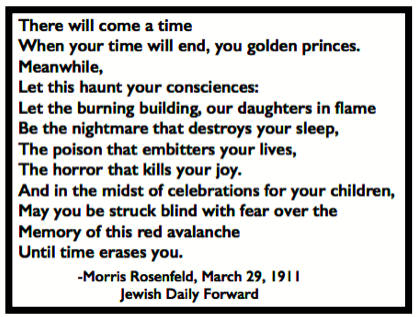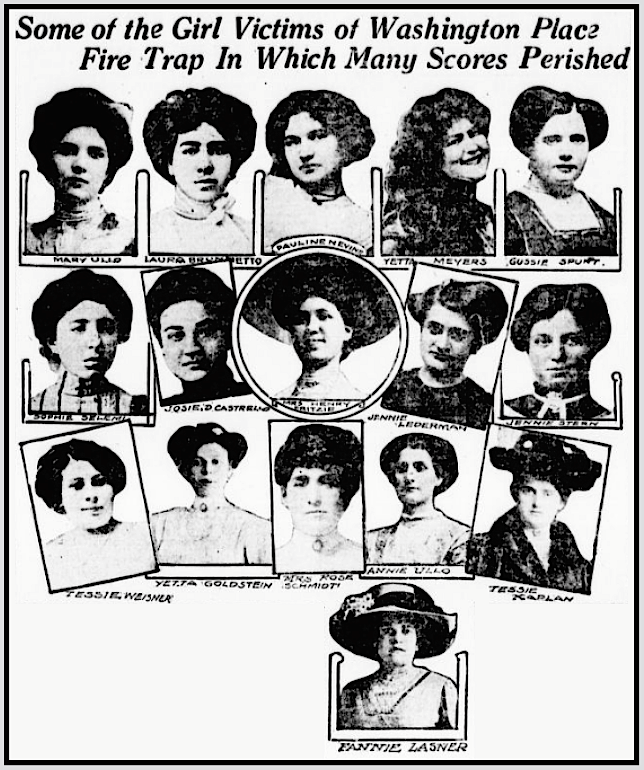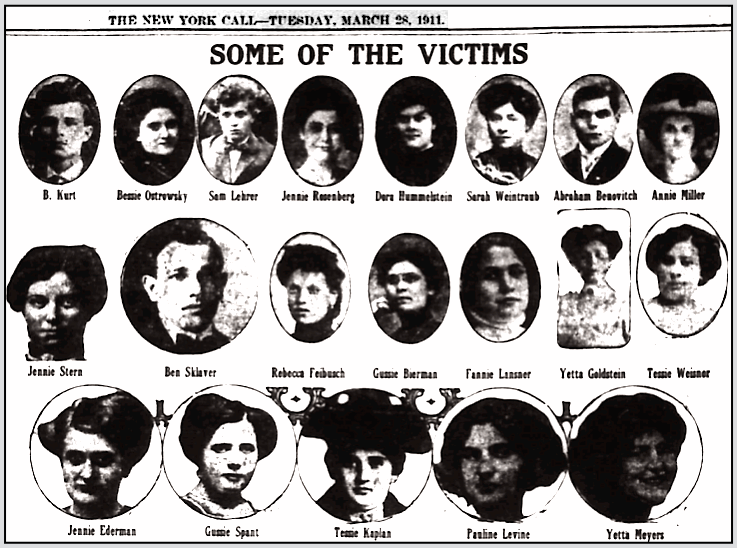 —————
—————
Hellraisers Journal – Friday May 5, 1911
“The Triangle Fire” by Martha Bensley Bruere, Part I
From Life and Labor of May 1911:
The Triangle Fire
By Martha Bensley Bruere
The Triangle Shirt Waist Shop in New York City, which was the scene of the great fire on March 25th, when 143 [146] workers were killed, was also the starting point of the strike of the forty-thousand shirt waist workers in 1909.
The girls struck because they wished to stand together for decent shop conditions, wages on which they could live and reasonable hours, and neither Mr. Harris nor Mr. Blanck, both of whom were members of the Manufacturers’ Association, would allow their workers to unite in any way at all.
It happened that I did picket duty morning and night before that shop and saw the striking girls go up to the strike-breakers and ask timidly:
“Don’t you know there’s a strike by the Triangle?”
It was before this Triangle Shop that the girls were clubbed by the police and by the hired thugs who assisted them; and it was in the streets around it that a large number of arrests were made. The girl pickets were dragged to court, but every one from this shop was discharged. The police and the government of the city had banded themselves together to protect the property of Harris and Blanck, the Triangle Shirt Waist firm.
The six hundred girls who worked at the Triangle Shop were beaten in the strike. They had to go back without the recognition of the union and with practically no change in conditions. On the 25th of March it was these same policemen who bad clubbed them and beaten them back into submission, who kept the thousands in Washington Square from tramping upon their dead bodies, sent for the ambulances to carry them away, and lifted them one by one into the receiving coffins which the Board of Charities sent down in wagon loads.
I was coming down Fifth Avenue on that Saturday afternoon when a great swirling, billowing cloud of smoke swept like a giant streamer out of Washington Square and down upon the beautiful homes in lower Fifth Avenue. Just as I was turning into the Square two young girls whom I knew to be working in the vicinity came rushing toward me, tears were running from their eyes and they were white and shaking as they caught me by the arm.
“Oh,” shrieked one of them, “they are jumping.”
“Jumping from ten stories up! They are going through the air like bundles of clothes and the firemen can’t stop them and the policemen can’t stop them and nobody can’t help them at all!”
“Fifty of them’s jumped already and just think how many there must be left inside yet”—and the girls started crying afresh and rushed away up Fifth Avenue.
A little old tailor whom I knew came shrieking across the Square, tossing his arms and crying, “Horrible, horrible.” He did not recognize me, nor know where he was; he had gone mad with the sight. The minister of a fashionable church sank limp and white on one of the park benches and covered his face with his hands, unable to face the horror. For four blocks to the east the streets ran ankle deep with the water from the fire engines, and the crowd surged back and forth, breaking in repeated panics as ambulances and automobiles filled with injured and dead rushed through.
The police tried to keep the fire lines. The reserves were called out and formed into a cordon of blue backs against the surging crowd, but the Triangle shop was just on the edge of the quarter where live half a million Italians; the working day was over and thousands of factory workers were pouring into Washington Square on their way home, the mass of workers pressed in and in on the fire lines, and what can policemen do against a whole quarter mad with terror at seeing its sisters and daughters burned before its eyes? Can you quiet a man who thinks that the charred mass over which a merciful blanket has just been thrown, is his newly married wife?
Sometimes the mob shrieked that the still forms on the pavement were not dead; sometimes they raged at the firemen because they did not do the impossible, for the extension ladders only reached to the sixth story, while the fire was on the eighth, ninth and tenth—the scaling ladders were useless—the girls jumped so rapidly and so many together that the life nets broke through, and as Battalion Chief Worth said afterward:
“There was no apparatus in the department which could have been of service.”
The city government which, through its policemen and detectives had compelled the girls to go back to work at the Triangle Shop, was quite powerless to save their lives.
But why did the girls jump to death? “Why did they wait and burn in their workrooms? Why didn’t they leave the building? Said Sadie Bergida:
We all ran for the Washington Place door [on the eighth floor]. When we tried to open it we found it was locked. The flames were racing up behind us and the room was filled with smoke. We girls struggled desperately to force open the door; there was a snap lock on the inside, however, and it held till Mr. Brown, a machinist, ran up and throwing his body against the door, burst it open. But most of the girls by that time had rushed to the Greene Street door. Of what happened after that I have only a very faint recollection. It seems to me that I tumbled down the stairs to the street.
Said Tessa Benani:
My sister Sarah and I worked alongside of each other and our cousin Josey worked a little ways off. We ran with about forty other girls to the Washington Place doors and found them locked, and we beat on those iron doors with our bare hands and tried to tear off the big padlock. The girls behind us were screaming and crying. Several of them, as the flames crept up closer, ran into the smoke, and we heard them scream as the flames caught their clothes. One little girl, who worked at the machine opposite me, cried out in Italian, “Good-bye, good-bye.” I have not seen her since. My cousin Josey staggered through the mob and made direct for the flames. The next I heard of her was when they brought her body home from the morgue. She had jumped! Half a dozen other girls went into the flames that were eating up the Greene Street side. They all jumped from the windows.
Tessa and Sarah Benani also escaped when William [Louis] Brown broke open the door [on the eight floor.]
Around the entrance to the freight elevator which the girls were expected to use was a partition with a narrow door through which the girls could only pass one at a time. Some of the girls did not even know of the existence of the passenger elevator reserved for officials of the firm, which might have saved them. There was a small stairway to the roof by which N. Harris and Blanck and a few of their relatives escaped; but I have been unable to discover that any of the employees even knew of its existence.
There were two reasons why these three natural exits, the doors to the stairway, the elevator, and the roof were obstructed; first, to guard against a sudden exodus of employees in concerted protest; second, to prevent the girls stealing anything. Said Ida Deutchman:
This is the worst shop I ever worked in. When applying for work you must undergo a half hour examination about union affiliations. When a girl was hired, after working at the machine she would again be asked by the man in charge of the floor if she was a member of the Union. For the five months I worked in the shop I saw women come and go on account of the spy system they have.
When leaving work they have men at the Greene Street door searching all the girls. We were made to open our pocketbooks, and when a girl didn’t do it she was made to come up two or three flights and show that she didn’t have a piece of lace or anything else. A girl could not carry a waist in her pocketbook, and all one could steal was a piece of lace or embroidery worth two to three cents. Leaving work we were treated worse than prisoners.
After the fire a member of the Women’s Trade Union League consulted a fire expert as to what could be done about locked doors such as these, which are plenty enough in New York. Said he:
Yes, the doors ought to be open, of course. It’s all right to talk about it. But practically, you know—practically it can’t be done! Why, if you had doors open so that the girls could come and go, they might get away with a lot of stuff. Why, the doors have got to be locked. Haven’t you got to protect the manufacturer?
And this not a week after the fire!
But there is still the question:
“Why didn’t the girls come down the fire escape? There was one, wasn’t there?”
Yes, there was one—just one! According to the official report, if there had been, no fright or panic this fire escape would have emptied the building in three hours. The girls were all dead in twenty minutes!
Then again why did not the girls use the fire extinguishers apparatus required by law to be put in buildings of that class?
Said Mr. Harris of the firm on the witness stand:
I can truthfully say that I never saw a length of hose or stand-pipe in the building.
An order had gone out to instal automatic sprinklers in factories, but the manufacturers had organized to fight it because it meant so great an expenditure.
No! there seems to be no doubt of the reasons which prevented the girls from either using the fire escape or putting out the fire themselves.
[Photographs and emphasis added.]
~~~~~~~~~~~~~~~~~~~~~~
SOURCES
Quote Morris Rosenfeld fr Triangle Requiem, JDF Mar 29, 1911, L Stein 1962
https://trianglefire.ilr.cornell.edu/primary/testimonials/tf_protest.html
http://historymatters.gmu.edu/d/5479/
Life and Labor
“Published by the National Women’s Trade Union League”
(Chicago, Illinois)
-May 1911, page 137
“The Triangle Fire” by Martha Bensley Bruere
https://babel.hathitrust.org/cgi/pt?id=uc1.b3859487&view=2up&seq=147
IMAGES
Triangle Fire, Some Girl Victims, NY Eve Wld p3, Mar 27, 1911
https://chroniclingamerica.loc.gov/lccn/sn83030193/1911-03-27/ed-1/seq-3/
Triangle Fire, 20 Victims, NY Cl p2, Mar 28, 1911
https://www.marxists.org/history/usa/pubs/the-new-york-call/1911/110328-newyorkcall-v04n087.pdf
See also:
“What is to be Done” by Martha Bensley Bruere
https://trianglefire.ilr.cornell.edu/primary/testimonials/ootss_MarthaBensleyBruere.html
Tag: Triangle Shirtwaist Factory Fire
https://weneverforget.org/tag/triangle-shirtwaist-factory-fire/
Tag: NYC Waistmakers Uprising of 1909-1910
https://weneverforget.org/tag/nyc-waistmakers-uprising-of-1909-1910/
re Louis Brown unlocking 8th floor door, see:
The Triangle Fire
-by Leon Stein
Cornell University Press, Jan 15, 2011
-page 38 (note my copy is 1985 edition)
https://books.google.com/books?id=Bz67-uqTwYwC
~~~~~~~~~~~~~~~~~~~~~~~~~~~~~~~~~~~~~
Triangle Fire Memorial Concert
Performed at Jusdon Memorial Church in Greenwich Village on March 25th, 2010, on the occasion of the 99th anniversary of the Triangle Shirtwaist Factory Fire.
Three songs by Elizabeth Swados, with music direction by Kris Kukul:
“Morris Rosenfeld” – soloist Adam Kern
At 3:23 – “Shirt” – soloists Emily Mattheson and Amy Jackson
at 6:15 – “Rosie Schneiderman” – soloist Amy Jackson


